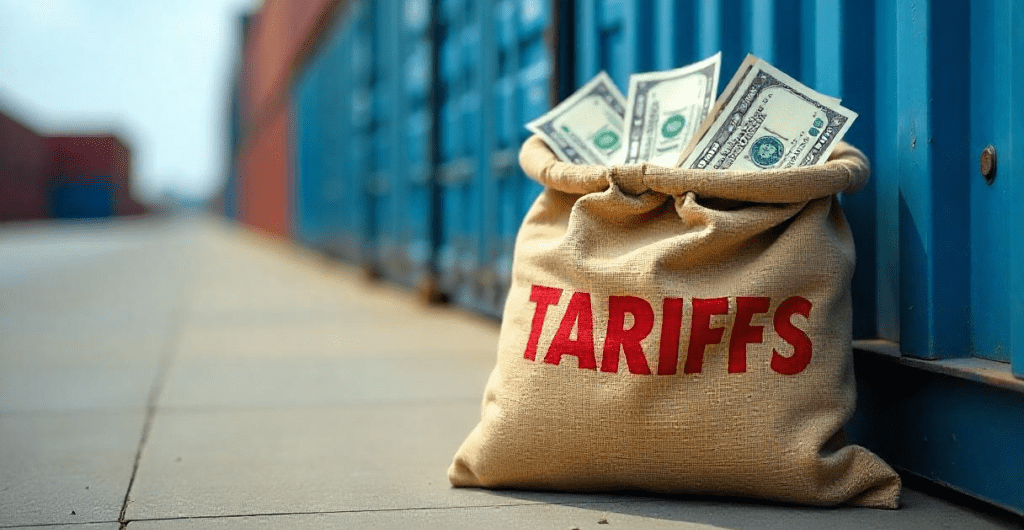Today’s Tariff Impact
Since early 2025, the United States has implemented a series of significant tariff policies that have dramatically raised the cost of imported goods. As of April 2025, the U.S. average effective tariff rate is 22.5%—the highest rate since 1909. These steep increases are affecting virtually all industries, with particularly severe impacts on small businesses that lack the negotiating power and financial reserves of larger corporations.
(Source: Yale University, April 2025)
A tariff is essentially a tax levied on imported goods when they enter the country. When the U.S. government imposes tariffs, they’re paid by the domestic companies that import the affected goods or materials. For small businesses, this creates an immediate financial burden that must either be absorbed (reducing profit margins) or passed on to customers (potentially reducing sales).
Immediate Impacts on Small Businesses
Here are the four major ways tariffs are directly affecting small businesses today:
Rising Cost of Goods
With added duties on imported goods, businesses face increased costs for raw materials and inventory. For example, a restaurant that sources specialty ingredients globally or a boutique clothing store depending on imported fabrics must either absorb the added costs or increase prices—neither of which is an easy choice.
Supply Chain Disruptions
The tariffs have led to supply chain delays as businesses look for alternative suppliers. Shipping timelines have extended, and businesses relying on “just-in-time” inventory systems feel the pinch as they struggle to stock shelves on time.
Shrinking Profit Margin
Tariffs force small businesses into a difficult position: either absorb the increased costs and watch profit margins shrink, or raise prices and risk losing customers. Most companies end up doing both—partially increasing prices while also accepting lower profit margins—as the full cost increases typically cannot be passed to consumers in competitive markets.
Cash Flow Challenges
Tariffs create immediate financial pressure by increasing costs at every stage of the supply chain. Small businesses typically operate with thinner cash reserves than larger corporations, making it harder to absorb these sudden increases. Additionally, many small businesses lack the negotiating leverage to secure better terms from suppliers or the flexibility to quickly pivot to alternative sources.
Strategic Inventory Management Advice for Clients
Here’s how financial institutions can help small businesses handle tariff challenges:
Step 1: Discuss inventory timing strategies. Talk with clients about buying inventory before tariffs hit. Explain both benefits (cost savings) and risks (cash flow strain, storage costs). Help them calculate exactly how much capital they’ll need and whether you can provide financing options.
Step 2: Explore product and supply alternatives. Work with clients to identify which imported materials could be replaced with local options. Discuss whether redesigning products might reduce tariff exposure while maintaining quality and profit margins.
Step 3: Introduce helpful technology tools. Suggest inventory management systems that show real-time stock levels and sales patterns. These tools help businesses order the right amounts at the right times, preventing both stockouts and excess inventory during uncertain tariff periods.
Step 4: Review pricing models and cash flow impacts. Help clients calculate whether their current prices can absorb tariff costs or if increases are necessary. Create simple spreadsheets showing different scenarios based on various tariff rates, helping them prepare for multiple outcomes.
How Financial Institutions Can Support Small Businesses
Financial institutions can offer several specific solutions to help small businesses mitigate the impacts of these policies. From specialized financing options to digital tools, these resources address the exact challenges businesses face when dealing with rising import costs.
Here’s how institutions can provide meaningful support in each key area:
1. Bridge Lending Opportunities
Interest-only revolving lines of credit can provide small businesses with the necessary funds to manage inventory challenges without immediately impacting cash flow. These lines allow businesses to draw funds as needed and pay only the interest initially, offering flexibility in financing large inventory purchases.
2. Essential Business Tools
Financial institutions can help small businesses get access to the tools they need to run their business. Small businesses spend $340 a month cobbling together solutions – they need inventory management systems but maybe can’t afford them. By partnering with technology providers, banks can offer these essential tools as part of their relationship, creating immediate value.
3. Cost-Saving Partnerships
Financial institutions can deliver immediate value by providing small businesses with digital financial tools through their network of partners. These technology partnerships help businesses reduce operational expenses while gaining access to essential tools for inventory tracking, invoicing, payment processing, and customer management—all critical for navigating tariff uncertainties.
4. Embedded Lending Solutions
Embedded lending represents a major market shift, integrating loans directly into digital back-office platforms where businesses already operate. This “lending at the point of need” approach can be particularly valuable for businesses managing tariff-related inventory challenges.
5. Working Capital Optimization
Small businesses need more than just loans – they need financial tools that work together. Leading financial institutions are now combining lending with digital payment platforms to create powerful solutions. This means businesses can access working capital based on their unpaid invoices and adjust their repayment schedules to match their cash flow.
Takeaways
The current tariff environment presents significant challenges for small businesses. By understanding these challenges and providing targeted support, financial institutions can strengthen relationships with business clients while helping them navigate difficulties.
As tariffs continue to reshape the business environment in 2025, the financial institutions that thrive will be those that combine digital tools with personalized service to meet the evolving needs of their small business clients.
By partnering with Finli to offer comprehensive financial solutions, institutions can position themselves as essential allies in their clients’ success despite the ongoing tariff challenges. Ready to learn how your institution can better support small businesses navigating tariff-related inventory challenges?
Contact Finli today to discover how our integrated platform can help you deepen relationships and grow core deposits while providing essential services to your small business clients.




